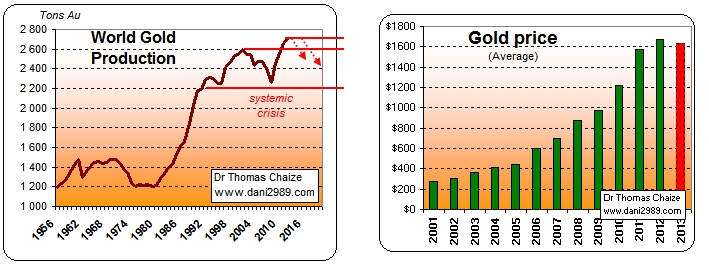
In 2012 world gold production reached 2,700 tonnes of gold (USGS) – slightly higher than production in 2011 and marginally higher than 2,600 tonnes of gold in 2001 (previous highs). This increase masks major changes in the structure of production costs for gold mines around the world. In 2001, for 2,600 tonnes, an ounce of gold was worth $271. In this past year it was worth $1,669. For 3.8% of additional production, the price of an ounce of gold has risen 615%.
China is the world’s largest gold producer in 2012 with 370 tons produced. It remains at the forefront since 2007. Its production has increased threefold since 1991 and by fifty times since 1980. This increase in Chinese gold production is not miraculous. In 1980 production was largely ignored by the rest of the world. China has been a major producer of gold for centuries, this increase is the result of the “formalization” of its production and the modernization of its mines.
The second largest producer is Australia with 250 tonnes of gold. Gold production in Australia is slightly higher than its low in 2008 with 233 tons but below its peak in 1998 with 312 tons of gold.
USA is third with 230 tonnes of gold. The situation in the United States is similar to Australia. Their production is slightly above the low of 2008 (223 tons of gold) and below the peak year of 1998 (366 tonnes of gold).
With annual production of 205 tonnes of gold, Russia is the fourth largest gold producer in the world. Despite steady growth since 1998, Russian gold production is still below past levels of production from the Soviet Union.
South Africa is the fifth largest gold producer in the world with 170 tonnes. This represents only 17% of the past production from 1969 to 1970, which was 1,000 tonnes of gold. 1,000 tonnes of gold is the historical record, no country in the world has never produced as much gold in a single year. South Africa lost its crown as the leading producer of gold in 2007 after a century of rule.
Sixth, the gold production of Peru is close to that of South Africa with 165 tons of gold produced in 2012.
Gold production in Canada was 102 tonnes, it is the seventh largest producer of gold. Despite a small increase this year, today’s production rates are well below the 166 tonnes of gold produced in 1998.
Eighth position goes to Indonesia with 95 tons of gold. This level is far below its peak production of gold in 2006 at 203 tonnes.
Production from these eight major gold-producing countries continues to decline. They represent more than 59% of world gold production against 92% in 1970. Today, gold produced from these eight major countries and more than a hundred smaller countries is required to match the record production from South Africa in 1970.
The inexorable decline in gold production in South Africa and the stagnation/decline from historical producers such as USA, Australia, Canada, Peru and Indonesia have lead to radical changes in the structure of production costs. The growing trend towards the fragmentation of world gold production has many consequences, for example, a decrease in the resilience of gold mines in the event of lower gold prices. In other words, less profitable mines will close faster if a decline in the price of gold continues.
From 2008 to 2012 world gold production increased from 2,260 tonnes to 2,700 tonnes of gold. Gold production was driven by an increase in demand and a temporary decrease in production costs due to the 2008 crisis. We currently have a reverse situation, the price of an ounce of gold is in a weak position (average annual decline in 2013) while production costs have increased.
If these trends continue, mine closures as a result of lower gold prices and higher production costs should initiate a decline in world gold production for 2013.
To view MiningFeeds comprehensive list of publicly traded gold companies arranged by market capitalization – CLICK HERE.



 Follow us on Twitter
Follow us on Twitter Become our facebook fan
Become our facebook fan











Comments are closed.